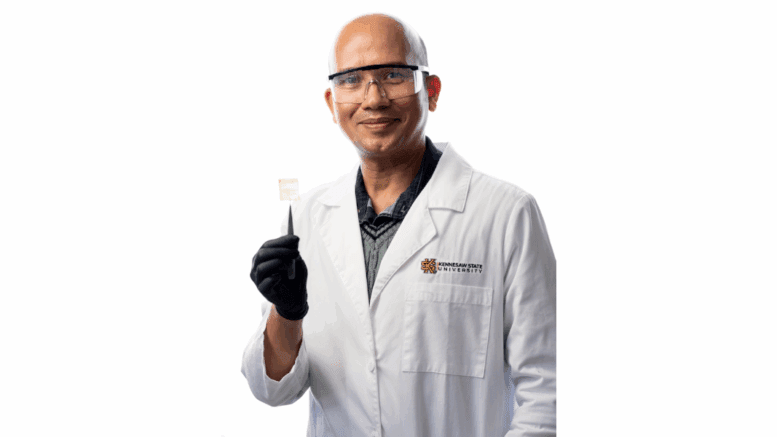The following article by Darius Goodman, with photo by Darnell Wilburn, first appeared on the Kennesaw State University website, republished with permission:
Discarded plastics are among the leading contributors to pollution worldwide, but Kennesaw State University researcher Bharat Baruah believes transparent wood could serve as a viable alternative.
The professor of chemistry and biochemistry is exploring whether specially processed transparent wood can replace plastic in consumer electronics, packaging, and many other goods as a more ecofriendly solution.
“It would be a game changer for sustainability,” said Baruah, who teaches in Kennesaw State’s College of Science and Mathematics. “Imagine eyeglasses made from transparent wood that detect fatigue in truck drivers by monitoring blinking patterns. Most food storage bags are made with plastic, too. If we can make a version with wood, it would be safer for the environment.”
Baruah’s approach is a departure from existing transparent wood technologies. Many products on the market today are strengthened with epoxy resins that are not biodegradable. To address this, Baruah and alumna Ridham Raval are developing entirely natural materials to replace epoxy in transparent wood products inspired by centuries-old buildings made with natural cement mixtures.
While growing up in India, Baruah observed how traditional construction methods used sand, sticky rice, and egg whites to create durable structures before modern cement existed. Baruah hypothesized that these same materials could enhance the strength and stability of transparent wood. Wood consists of three main components: cellulose, hemicellulose, and lignin. To make the wood transparent, lignin and hemicellulose are removed. Rather than replacing those components with epoxy, Baruah’s method uses egg whites and rice extract, making the wood stronger and more environmentally friendly.
The material has been tested on a birdhouse, transforming it into a one-window insulated home. Baruah and Raval evaluated the wood’s energy efficiency by placing a heat lamp underneath, finding the material offers better insulation.
Beyond its use in building material, Baruah said transparent wood has potential applications in consumer electronic devices like wearable sensors and solar panels. Future research projects will focus on increasing transparency of the wood and alternative conductive materials like graphene to maintain biodegradability and conductivity.
